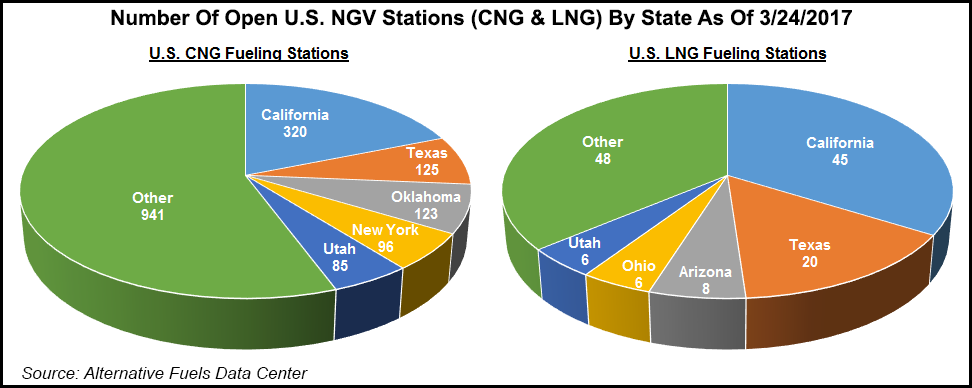Infrastructure | NGI All News Access
California Doubles Down on Cleaner Transportation; SoCalGas Sees NGV Gains
While calling for continued cooperation with federal and local authorities, California state air regulators on Thursday approved the next generation of air quality standards that are aimed at further reducing emissions from transportation vehicles, a move that natural gas vehicle (NGV) advocates welcomed.

Comprehensive statewide and regional efforts were approved by the California Air Resources Board (CARB), which established a state strategy for California’s State Implementation Plan (SIP) that outlines a commitment to further reduce vehicle emissions to meet federal air quality standards over the next 15 years even though theTrump administration has raised questions about whether those standards will be enforced at the national level.
CARB also approved a regional air quality plan for the South Coast Air Quality Management District (SCAQMD) that covers the four-county area in the greater Los Angeles Basin that is home to more than half of the state’s 38 million residents.
“[This] action builds upon California’s efforts over the last 50 years and sets the stage for a range of actions into the next decade,” said CARB Chair Mary Nichols, who added that California intends to continue its “air quality leadership” by working with “our federal and local partners.” Nichols said the actions provide a “pathway to cleaner air, along with a vibrant economy.”
A spokesperson for Sempra Energy’s Southern California Gas Co. (SoCalGas) called the SCAQMD plan and the SIP strategy “important milestones” that are the result of four years of input from industry, state agencies and the general public. The gas-only utility, the nation’s largest, agrees with the proposed steps for accelerating mobile source nitrogen oxide (NOx) reductions, the utility spokesperson said.
“The single most impactful strategy for reducing mobile source emissions is to incentivize the deployment of near-zero heavy duty [NGV] trucks that are commercially available today,” the SoCalGas spokesperson said. “These next-generation heavy-duty natural gas engines are the most cost-effective solution to help meet our air quality and climate change goals.”
With an obvious interest in growing the NGV market, SoCalGas has been promoting the latest heavy-duty NGV engines for their 90% reduction of NOx, contending that when using renewable natural gas, or biomethane, the near-zero engines can reduce greenhouse gas emissions by more than 80%. SoCalGas plans to work with local air districts and CARB to “develop cost-effective measures” to implement the plans.
Separately on Thursday, NGV engines were deconstructed by American Power Group Inc.’s (APG) Dan Goodwin, vice president for technical marketing and government affairs, on a webinar hosted by the Northwest Gas Association. He said there is a gap in the NGV heavy-duty market once the engine requirements get larger than 12 liters.
Goodwin said APG is supplying a “bridge” through a dual-fuel, NGV/diesel conversion for engines in the 13- to 16-liter heavy-duty truck segment. In the diesel market’s seven segments, heavy-duty trucks account for more of the market than the other six segments (transit buses, airport shuttles, etc.) combined, he said.
“The goal is to cut back this diesel consumption by more than half by using natural gas,” which can both reduce the volumes of imported oil and improve air quality, he said.
The larger, dual-fuel conversion kit adapted engines are ideal for fleets engaged in longer range, rough, and terrain heavier load cargoes, APG’s marketing approach emphasizes. “This is where you really need technologies like ours,” Goodwin said. “We think that dual fuel provides this kind of a bridge technology for fuel producers or retailers and utilities to increase the consumption of natural gas that will build more [NGV] infrastructure statewide, regionwide and nationwide, so we can get more and more trucks into the system and out of producing these large emissions.”
Goodwin said he was unsure when there might be a breakthrough in dedicated NGV engines larger than 12 liters. The larger sized, higher horsepower engines so far have run into engineering difficulties at the 15-16 liter level, he said.
In Tampa, FL, earlier this month the Hillsborough Area Regional Transit Authority (HART) selected Love’s Trillium CNG to provide operations/maintenance services in the transit operator’s compressed natural gas (CNG) fueling station. Trillium won a competitive bidding process and will complete a series of upgrades at existing facilities for HART.
As the first transit agency in Florida to switch to CNG, HART continues to have some “serious, long-term goals” for its use of the natural gas fuel, said Bill Cashmareck, Trillium director.
HART began converting its vehicles to CNG in 2014 with a private CNG station using four 300-horsepower IMW compressors. Trillium will replace three control panels and develop custom programming that allows the station to better use available fuel capacity. “The upgrades will result in a more energy-efficient, cost-effective operation for HART,” a Trillium spokesperson said.
In the liquefied natural gas (LNG) marine transportation sector, interest continues to pick up as evidenced by Crowley Maritime’s recent launch of the first of its two LNG-fueled commitment-class cargo vessels at the VT Halter shipyard in Pascagoula, MS, that is scheduled to be delivered for Caribbean service later this year. The El Coqui and its sister ship Taino will be operated by Tote Maritime between Jacksonville, FL, and Puerto Rico.
And in the Netherlands, Rotterdam-based Van Oord ordered its first LNG-fueled vessel, the 224-foot Werkendam, now under construction at Neptune Shipyard. The crane-equipped workboat is slated to be generally deployed for Netherlands-based projects.
© 2024 Natural Gas Intelligence. All rights reserved.
ISSN © 1532-1231 | ISSN © 2577-9877 |
